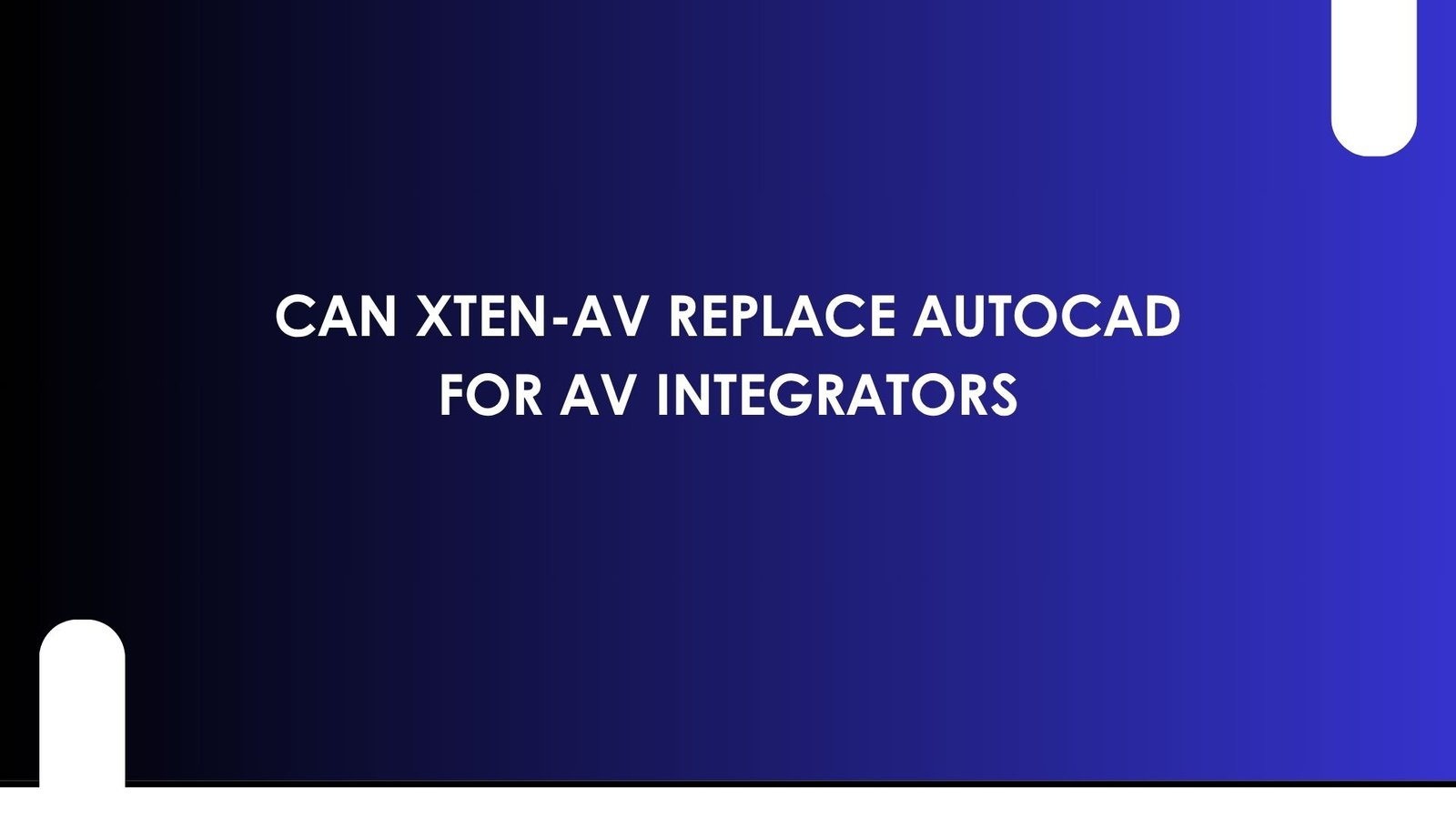When it comes to AV system design, few tools have been as widely adopted over the years by AV integrators as AutoCAD. Known for its powerful drafting capabilities, AutoCAD has been a go-to platform for engineers, architects, and AV professionals. But as the industry shifts toward cloud-based platforms, automation, and smart design features, a new generation of tools has emerged. One platform leading this shift is XTEN-AV.
The question many AV integrators are asking now is this — can XTEN-AV replace AutoCAD
In this blog, we will explore that question by comparing the features, benefits, and workflows of both tools, focusing on what modern AV professionals really need in 2025.
XTEN-AV at a Glance
XTEN-AV is a cloud-based AV design and documentation software built specifically for AV system integrators and consultants. Unlike traditional drafting tools, XTEN-AV combines artificial intelligence, a library of real manufacturer products, and automation to streamline the entire design process.
With XTEN-AV, users can:
- Auto-generate single line diagrams and rack layouts
- Access an extensive, updated library of AV components
- Generate proposals, bills of materials, and cable schedules instantly
- Collaborate in real time with team members
- Customize templates for rapid project turnaround
It is designed to remove the complexity of traditional CAD workflows and replace them with smart, efficient processes built for AV.
AutoCAD and Its Place in AV Integration
AutoCAD is one of the most powerful and flexible drafting tools available. It is used across industries for creating 2D and 3D blueprints, including AV designs, electrical schematics, architectural layouts, and more.
Its benefits include:
- Precision drawing tools
- Extensive customization
- Industry-wide compatibility
- Long-standing professional credibility
However, AutoCAD is a general-purpose tool. It does not come preloaded with AV-specific symbols, components, or automation features. That often leads to longer design times and the need for AV integrators to build custom blocks, scripts, and libraries from scratch.
Key Differences Between XTEN-AV and AutoCAD
Let us break down the comparison in categories that matter most to AV integrators.
1. Ease of Use
XTEN-AV is built with AV professionals in mind. The interface is intuitive, and the learning curve is much shorter than AutoCAD. Features like drag and drop components, auto-alignment, and AI-based suggestions make it user-friendly even for non-engineers.
AutoCAD, while extremely powerful, requires formal training. Drawing AV systems can involve multiple steps and manual effort, especially if you are not experienced with layers, block libraries, and annotation settings.
Winner: XTEN-AV
2. Speed and Efficiency
XTEN-AV dramatically speeds up the design process by using AI to place components, generate diagrams, and fill in documentation automatically. The software reduces the need for repetitive tasks, like placing symbols or labeling cables.
AutoCAD is manual. Everything from symbols to layouts must be created or imported. While experienced users can move quickly, it still takes time to draw and annotate a complete AV system.
Winner: XTEN-AV
3. Built-in Product Libraries
XTEN-AV gives users access to a constantly updated library of real AV products from top manufacturers. This includes model numbers, power specs, connectivity types, and dimensions. Designers can simply search and add components to their projects with a click.
AutoCAD does not include AV product libraries. Users must build their own symbol blocks or purchase them from third-party sources.
Winner: XTEN-AV
4. AV-Focused Features
XTEN-AV includes features like:
- Auto-generation of single line diagrams
- Rack elevation diagrams
- Cable labeling and routing
- Proposal generation with pricing
These are all standard features because the platform is purpose-built for AV workflows.
AutoCAD does not offer these features natively. To achieve similar results, users need additional plug-ins or must manually build their own systems.
Winner: XTEN-AV
5. Collaboration and Cloud Access
XTEN-AV is fully cloud-based. This means teams can work together in real time from anywhere. Files are automatically saved, versioned, and accessible from any browser.
AutoCAD can be used in the cloud through AutoCAD Web or Autodesk Cloud, but the experience is more limited. Real-time collaboration is not as seamless unless you are on high-end enterprise plans.
Winner: XTEN-AV
6. Integration with Proposals and Project Documents
In XTEN-AV, once you complete your design, you can generate a bill of materials, cable schedule, proposal document, and system scope without leaving the platform. These documents are linked to your design, which means updates are synced automatically.
AutoCAD has no built-in connection to proposals or project documents. All reports must be created separately, often manually.
Winner: XTEN-AV
7. Customization and Advanced Drafting
AutoCAD shines when it comes to custom drawings and detailed architectural layouts. If your work requires architectural coordination or precise integration with structural elements, AutoCAD offers the freedom to create anything from scratch.
XTEN-AV focuses on standard AV designs. It is not meant for architectural or civil engineering drafting, though it allows for room layout and equipment placement.
Winner: AutoCAD
8. Cost and Licensing
XTEN-AV offers flexible pricing based on the number of users and features needed. It is more affordable and scalable, especially for small and medium AV firms.
AutoCAD requires a higher upfront cost or subscription. It is a general-purpose tool with a premium price tag.
Winner: XTEN-AV
Can XTEN-AV Fully Replace AutoCAD
The answer depends on your business needs.
If you are an AV integrator focused on designing, quoting, and delivering AV systems like conference rooms, auditoriums, classrooms, or digital signage networks, XTEN-AV can absolutely replace AutoCAD for most of your daily work. It simplifies the process, reduces manual effort, and helps your team collaborate better.
However, if your work involves detailed architectural drawings, structural engineering layouts, or custom civil infrastructure, you may still need AutoCAD for specific tasks. That said, you can use both tools side by side—XTEN-AV for AV design and AutoCAD for architectural coordination.
Final Thoughts
The AV industry is evolving, and the tools we use must evolve with it. XTEN-AV is not just an alternative to AutoCAD—it is a purpose-built solution that understands the specific needs of AV integrators. With features like AI-driven design, real-time collaboration, automated documentation, and an extensive product library, XTEN-AV is redefining what it means to design AV systems in 2025.
For AV professionals seeking speed, accuracy, and automation, XTEN-AV is more than capable of replacing AutoCAD in most workflows. It is the future of AV system design—accessible, intelligent, and built for integrators.
Read more: https://postr.yruz.one/d-tools-vs-xten-av-which-av-design-software-should-you-choose












Leave a Reply